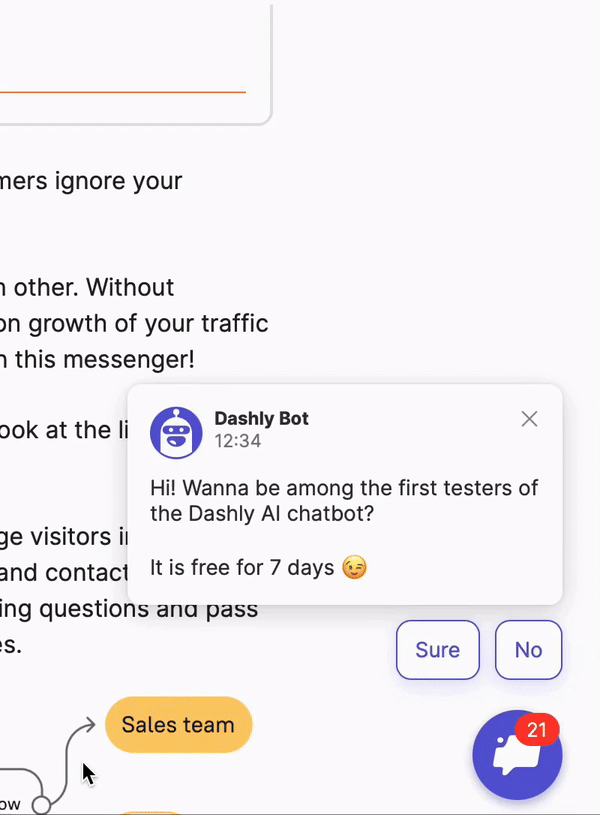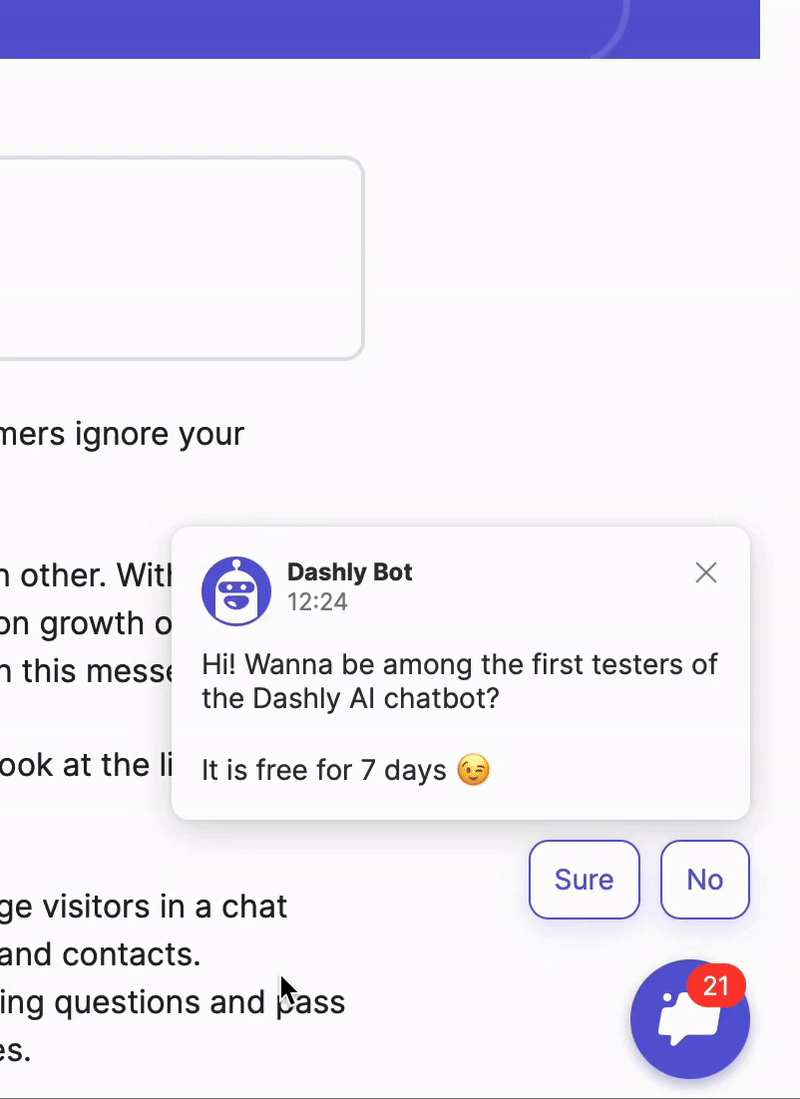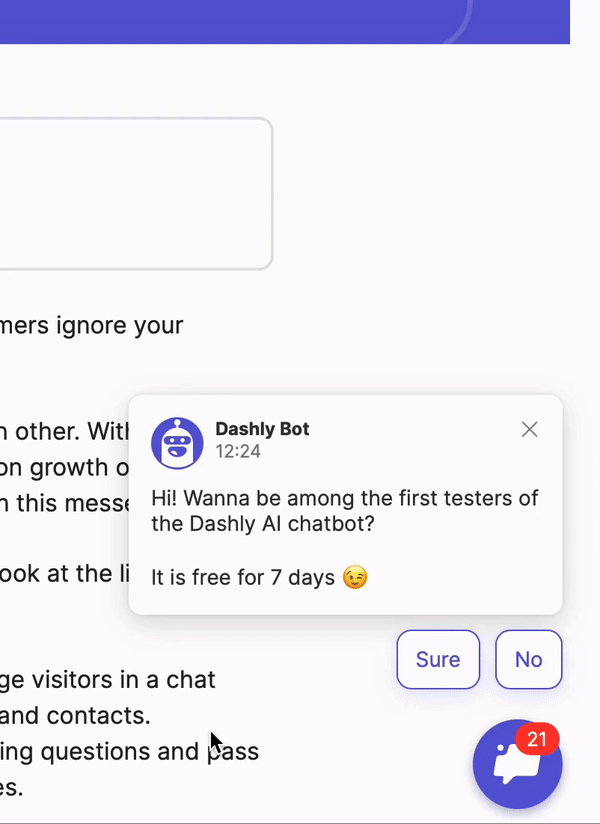How to structure your sales enablement team: 10 roles and responsibilities
Discover the secrets of rapid sales metrics growth from Dashly team experts. What strategies and tools to use, which pitfalls to avoid, what examples and best practices to follow.

Part 1: What is sales enablement? Definite guide + Strategy + Tools
Part 2: How to measure sales enablement: 20 metrics to track in 2024
Part 3: AI in sales enablement: 5 strategies to transform your sales process
Part 4: 10 steps to building a sales enablement strategy in 2024
Part 5: How to Create an Automated Sales Funnel: examples & tools
Part 6: 7 sales enablement best practices to empower your team
Part 7: Top 13 sales automation tools to propel your sales strategy
Part 8: 10 Sales Enablement Tools: Best Software To Grow Your Team Performance
Part 9: How to structure your sales enablement team: 10 roles and responsibilities
Part 10: Mastering sales automation: A comprehensive guide to best practices and tools
Dive into any high-achieving sales organization and you’ll find a secret weapon: a robust sales enablement team structure. Believe it or not, a strategic sales enablement organizational structure can skyrocket productivity by as much as 20%. It’s pivotal. Today, I’m peeling back the curtain on the anatomy of success within sales enablement — breaking down the must-have roles, from the linchpin sales enablement manager to the various critical team roles. Prepare to restructure and energize your team for peak performance. Let’s get down to business.
What is a sales enablement team?
A sales enablement team is a collective that arms sales professionals with the essential tools, content, and training to sell more effectively. It’s essentially the central nervous system that coordinates with the sales muscles, ensuring precise and powerful movements in the market.
For businesses of all sizes, having such a team isn’t just beneficial — it’s critical. It’s about ensuring that sales strategies are responsive, relevant, and results-driven.
Why can’t this mission-critical role be fulfilled by one person? Here’s the breakdown:
1. Complex Skill Sets Required
Sales enablement involves:
- Crafting and managing targeted content
- Conducting in-depth market research
- Facilitating comprehensive training programs
- Performing meticulous data analytics
2. Volume of Work. The sheer quantity of resources and support that sales teams require is more than a single individual can handle.
The sales enablement team structure and its complexity within a company will depend on various factors:
- Company Size. Smaller businesses might have a compact team with versatile roles, while larger entities typically need a more expansive team structure.
- Business Goals and Strategy. The objectives of the sales enablement initiatives will influence the roles within the team.
- Available Resources. Budgets and existing capabilities will shape how the sales enablement organizational structure is designed and implemented.
Adopting a tailored approach ensures that each sales enablement team works in sync with the company’s rhythms, fulfilling its role as an accelerator and efficiency booster in the sales process.
Read also:
👉 10 Benefits of Sales Funnel to Propel Your 2025 Success
👉 Maximizing Your B2B Marketing Sales Funnel Efficiency
3 Major Factors to for building sales enablement organizational structure
Creating a sales enablement organizational structure that resonates with the needs of your sales team is akin to crafting a bespoke suit — it must be tailored precisely to the wearer to be truly functional. Here are three major factors critical for building an effective sales enablement team:
- Alignment with Sales Objectives: The primary purpose of a sales enablement team is to ensure that sales objectives are met through efficient and informed support. This entails understanding the sales cycle from start to finish and creating a structure that provides sales representatives with the necessary training, content, and tools at each stage. The team’s activities must be in lockstep with sales strategies to facilitate a smoother, faster sales process, and ultimately, to close more deals.
- Understanding of Buyer Persona and Journey: Sales enablement isn’t just about providing training; it’s about equipping salespeople to meet the buyer at their point of need. As such, a strong enablement team is one that deeply understands the buyer persona and journey. This knowledge allows enablement specialists to curate resources and content that speaks directly to the prospect’s pain points and queries. When your team can anticipate and address these effectively, salespeople become trusted advisors rather than just vendors, which is critical in today’s solution-centric sales environments.
- Scalability and Flexibility: The rate at which a company can adapt its sales enablement strategies can spell the difference between agility or stagnation. A well-structured enablement team should be both scalable, to adjust to growing sales needs, and flexible, to swiftly pivot strategies when market trends shift. This might mean implementing training programs that can expand in scope, or creating content that can be easily updated. Investing in technology and processes that allow for these changes can help ensure that your sales enablement team is not just aligned with current objectives, but can also accommodate future growth and change.
Each of these factors plays a substantial role in molding a sales enablement structure that’s not only effective but also integrates seamlessly with the rhythms of your sales force. In tandem, they contribute to a robust and responsive enablement team that empowers your sales efforts and delivers impactful results.
How to build the sales enablement team guide
Each business carries its own distinct DNA, which means crafting the optimal approach to constructing your sales enablement team hinges on a unique set of considerations. Kicking things off requires pinpointing your enterprise’s aims in connection to its sales architecture — this involves understanding the synergy between sales and marketing units. It’s all about charting out a structured roadmap for assembling this critical team.
Set Realistic and Achievable Goals
At the heart of any operative tactic is the crystallization of objectives you’re aiming to hit:
- Are higher lead conversion rates on your radar?
- Is there a push to revamp or optimize the toolkit available to your sales force?
- Does appending a sales enablement team mesh with the current company framework?
- What scale of team will serve your needs effectively?
- And how will this nascent team align itself with your company’s overarching S.M.A.R.T. objectives?
Wading through these queries is an exercise in strategic contemplation, likely unfolding over several weeks with inclusive interdepartmental dialogues. The answers unearthed form the very cornerstone of your fledgling sales enablement team. Without a clear set of goals, spearheading a successful team inauguration is an elusive target, so it’s pivotal to deliberate extensively.
Paying particular heed to how the sales enablement team dovetails with ongoing marketing and sales functions is key. The enablement blueprint often mirrors marketing’s approach to content strategies all the while providing structural support to the sales contingent. Thus, prompt yourself: Should alterations to the marketing and sales squad warrant the advent of a dedicated enablement team focused on cohesive training and support? It’s a question that could redefine the thriving force behind your sales efforts.
Just as there is no one-size-fits-all definition of sales enablement, there is no one-size-fits-all team structure that will work at every company. The key to determining the ideal team roles for your function is to understand your mission and vision and your capacity to execute against that with your current team.
Formalize the Sales Enablement Process
Reflecting on insights from a 2019 study on sales enablement, companies that wielded a coherent strategy witnessed an average deal closure rate of 49%, standing 12% higher than counterparts lacking a defined blueprint. A sales enablement charter serves as a manifesto for your team — outlining their responsibilities, whom they empower, and the metrics used to gauge their triumphs.
While improvising individual roles with sales enablement responsibilities might seem like a quick fix, embracing an orchestrated enablement team structure is proven to enhance sales outcomes and fortify cohesion across company divisions. Establishing a structured approach for your sales enablement charter is quintessential. Without it, you risk crafting a team that is disorganized and potentially detrimental to the very productivity it’s intended to bolster. It can also lead to communication standstills across various factions within the enterprise.
Of particular importance is ensuring your sales enablement efforts are harmonized with your marketing and sales targets. Engaging in ongoing dialogues with these departments is crucial to underscore seamless collaboration. Yet, it’s vital to remember that a sales enablement charter is not set in stone. Agility within your adaptive strategy remains pivotal, allowing your company to navigate and react to evolving sales dynamics over time. It’s about striking the optimal balance that facilitates both stability and adaptability.
Automate lead qualification to save your SDR time and raise conversion to meeting with Dashly AI tools

Sales Enablement Team Structure and Roles
A common inquiry I receive is about the optimal configuration for a sales enablement team. Each enterprise has its unique nature, mirroring the distinctive blueprint of its sales division. Crafting an enablement team structure requires a deep dive into the specifics — ranging from the nature of the product to the ambition of the company and the landscape it navigates.
The proprietorship of sales enablement hinges on an array of criteria, such as:
- Size of the company
- Growth targets of the enterprise
- Does customer service play a role in sales?
- Politics within the company
- Dynamics of the market
- Ethos and principles of the organization
- Intricacies involved in the product offered
- Centers of influence and decision-making within the hierarchy
- Strengths and areas for improvement in content crafting
- Distinctive leadership approaches and management flair
Your company’s structural DNA, the sales processes in use, and the prevailing work culture bear significant weight in designating the reins for sales enablement. The essence to grasp is that the responsibility for enablement can be centralized or distributed, nestled in various departments, all determined by the aforestated aspects.
Focusing on the Sales Enablement Team Structure, these teams play a pivotal role in:
- Orchestrating strategic account plans
- Offering backing during deal negotiations
- Managing and responding to requests for proposals (RFPs)
- Engineering business case rationales
- Curating vital sales materials
- Conducting training and onboarding regimes
The makeup of the sales enablement team hence might appear as follows, always malleable to the requirements cast by the specifics of your organization, the current needs of sales teams, and the dynamics of the markets they conquer.
Chief Enablement Officer
The Chief Enablement Officer is the strategic leader of the sales enablement operation. This high-level advocate connects enablement strategies to business outcomes.
Responsibilities:
- Envisioning the overarching strategy for sales enablement within the organization
- Aligning enablement initiatives with corporate goals and objectives
- Advocating for enablement resources and budget at the executive level
- Liaising between departments to ensure a unified approach to sales training
VP of Sales Enablement
The VP of Sales Enablement, often the right hand of the Chief, translates vision into actionable programs.
Responsibilities:
- Executing the sales enablement strategy
- Overseeing the creation and delivery of enablement tools
- Tracking progress and adapting strategies in response to data feedback
- Building and maintaining relationships within the sales teams
Director of Sales Enablement
The Director of Sales Enablement leads a specific area within the broader strategy, such as sales training or content management.
Responsibilities:
- Managing day-to-day operations of their enablement focus area
- Collaborating with various department heads to optimize sales tactics
- Supervising teams responsible for executing initiatives
- Ensuring alignment between sales enablement tools and sales team needs
Sales Enablement Manager
This hands-on role focuses on the implementation and refinement of enablement resources.
Responsibilities:
- Developing and maintaining enablement resources
- Facilitating the distribution of sales tools and content
- Providing feedback to senior enablement roles on material effectiveness
- Assisting with the coordination of training and development programs
Program Manager
Program managers design and oversee specific sales enablement projects or campaigns.
Responsibilities:
- Planning, executing, and closing enablement projects
- Tracking project performance and milestones
- Communicating updates to stakeholders
- Identifying risks and managing issues throughout the project lifecycle
Instructional Designer
The instructional designer is the architect behind the educational aspects of the enablement team, crafting training materials.
Responsibilities:
- Designing and developing sales training modules
- Ensuring materials are engaging and educational
- Employing adult learning principles to increase retention
- Tailoring training elements to different roles within the sales team
Sales Enablement Coordinator
Sales Enablement Coordinators ensure the smooth operation of sales enablement strategies.
Responsibilities:
- Managing logistics for sales training and onboarding
- Supporting sales enablement managers in the execution of tasks
- Contributing to the tracking and reporting of enablement metrics
- Acting as a liaison within the sales enablement team
Content Specialist
Content specialists are the creatives in the team, focusing on the production, curation, and maintenance of sales materials.
Responsibilities:
- Crafting compelling content that aligns with sales strategies
- Working closely with marketing to ensure content consistency
- Updating sales materials to reflect current market information
- Managing content libraries and databases
Sales Coach
Sales coaches provide the one-on-one guidance needed to refine and improve sales techniques.
Responsibilities:
- Conducting individual training sessions with sales representatives
- Observing sales calls and providing constructive feedback
- Identifying areas for development and creating personalized improvement plans
- Boosting overall sales team performance through targeted coaching
Performance Analyst
Performance analysts are key to understanding the ‘what’ and ‘why’ behind sales outcomes.
Responsibilities:
- Collecting and analyzing sales and training data
- Uncovering insights that drive strategic enhancements
- Reporting findings to the sales enablement and sales teams
- Suggesting changes to optimize training and enablement effectiveness
In building a robust structure, organizations must integrate these sales enablement roles into their DNA, each taking on a specialized function that supports and amplifies the capabilities of the sales team, ensuring that teams are cohesive, well-equipped, and ready to succeed.
2x your sales by contacting the most promising leads first with Dashly AI chatbot

Where Should Sales Enablement Teams Report?
Sorting through the complexities of where a sales enablement team fits within an organization is highly contextual. It hinges on many variables — from the desired focal point to the nuances of your enablement organization’s ever-evolving role. It’s essential to adapt and communicate your vision and structure clearly throughout these shifts.
Selecting the right individuals to spearhead your teams who embody the company’s objectives, priorities, and needs is vital for success. Thus, the decision on the reporting line is as fluid as the structure itself. Whether nested within Sales, Marketing, or HR, or possibly as an organization-wide effort, the reporting can adapt to suit the evolving goals and slog of work culture.
The most crafted approach considers the company’s current phase and desired outcomes from sales enablement. Asking, “Where is my company now, and what do I need sales enablement to achieve?” will dictate the most aligned reporting structure within your sales enablement structure.
Enablement Reporting to Sales/Revenue Leaders
Naturally, aligning the sales enablement team with sales or revenue leaders seems logical — they are, after all, intended to bolster sales. Benefits of such a pairing are strong alignment with sales goals and priorities and streamlined access to resources and support.
However, this decision can potentially sideline other organizational roles, running the risk of a sales-centric tunnel vision. Despite that, some of the most successful sales enablement stories stem from a whole-organization approach.
Pros:
- In-sync with sales leadership
- Sets an impactful precedent
- Targets key sales priorities
- Aids in resource procurement
Cons:
- Overlooks broader organizational roles
- May foster a sales-only enablement perception
Enablement Reporting to Sales/Revenue Operations
When led by a strategic thinker, placing sales enablement under sales operations can be beneficial, particularly for data-informed companies. The sales enablement organization gains from data proximity, operational communication, and calendar synchronization.
Still, a misplaced overseer could reduce sales enablement to simply a training function, undermining its broader organizational benefits.
Pros:
- Embraces a data-centric enablement approach
- Stays metrics-focused
- Streamlines communication on operational matters
Cons:
- Risks being viewed as a training-only function
- Potential misalignment with broader sales and organizational goals
- Might lack strategic influence
Enablement Reporting to Marketing
Reporting to marketing can amplify your sales enablement structure with content-rich sales training and varied customer education materials.
Pros:
- Leverages content creation expertise
- Operates independent of roles
- Boosts marketing’s role and perception
Cons:
- May prioritize content over necessary sales skills
- Could lead to misalignment with sales and revenue goals
Enablement Reporting to Human Resources (HR)
HR’s evolving dynamic makes it a contender for housing sales enablement if your focus leans toward comprehensive staff development. HR can implement sales enablement as a vital cultural and learning tool, influencing the organization from within.
Pros:
- Promotes thorough learning and evaluations
- Scales enablement through systematic employee training
- Cultural advancement
- Redefines HR’s organizational clout
Cons:
- Might be viewed skeptically due to HR’s traditional image
- Could be confined to a training-centric role
- Might lack the punch to drive substantial change
In deciding where your sales enablement team reports, it’s a multidimensional decision — one that can propel your enablement organization towards its objectives when aligned adeptly with the right departments.
Maintaining sales enablement team
Staying on top of the game in sales enablement requires a blend of the right tools, continuous training, and vigilant monitoring. It’s the difference between a team that scales mountains and one that stumbles on molehills.
Sales and Marketing Tools
In our toolbox, the fusion of sales and marketing’s weaponry plays a pivotal role. For starters, we use dashly.io’s lead qualification and scoring chatbot. It’s a game-changer, sparing our sales team countless hours by filtering through the chatter to identify and prioritize hot leads. Then there’s Pipedrive CRM — an invaluable asset that helps us stay organized and keep our pipelines flowing smoothly. Pair that with Dashly’s behavior tracking capabilities, and you’ve got a formidable setup that captures the nuances of customer interactions, giving us the insights we need to tailor our approaches effectively.
Sales Enablement Training
Training is never a one-off event; it’s an ongoing journey. We implement a cyclical model of training that keeps our team’s skills sharp and knowledge up-to-date. Role-playing, sales scenarios, and regular knowledge refreshers ensure that our practices are second to none. What we learn today might be the edge we need tomorrow.
Monitoring and Analysis
But what’s a strategy without metrics to measure its impact? We’ve baked in-depth monitoring and analysis into our sales enablement organizational structure. Through a combination of Pipedrive metrics and behavior tracking, we continuously measure everything from lead response times to conversion rates. This data-driven approach allows us to zoom in on what’s working and recalibrate what isn’t.
Keeping up with sales enablement isn’t just about having the best tools or the most extensive training program. It’s about creating an ecosystem within your sales enablement team structure where these elements coalesce naturally, grow with your organization, and consistently foster winning strategies.
To summarize
In conclusion, identifying the optimal sales enablement team structure cannot be overstated. Ensuring that sales enablement roles and responsibilities harmonize with an organization’s operational rhythm is key to unlocking peak sales funnel conversions. The correct placement — whether it be within sales, marketing, operations, or HR — matters immensely. It shapes the enablement strategy, fortifies cross-departmental collaborations, and ultimately drives the cultural transformation that leads to sustained success. In this intricate dance of structure and strategy, placing the sales enablement piece just right makes all the difference.
Qualify and score leads on autopilot to contact the most perspective ones and save you SDR time

FAQ on sales enablement team
The structure of sales enablement is a strategic framework, composed of designated sales enablement job titles and roles, working to equip sales teams with tools and knowledge for peak performance. This infrastructure orchestrates training, content management, and tools deployment, pivotal for optimized sales execution.
A sales enablement team, featuring roles like sales enablement coordinator and VP of sales enablement, specializes in optimizing the sales process. They create and manage content, streamline communication, and conduct training. For instance, while the coordinator may focus on day-to-day support and content distribution, the VP of sales enablement oversees strategy alignment and cross-functional collaboration to boost overall sales performance. Each of these sales enablement job titles plays a critical part in driving successful sales outcomes.
The size of a sales enablement team hinges on the sales force’s needs and the company’s scale. Typically, a robust team might feature 3-10 specialized sales enablement positions, built to provide comprehensive support and training for the sales department’s effectiveness and success.
To organize sales enablement effectively:
1. Define the sales enablement org structure based on company goals.
2. Assign clear sales enablement roles, such as strategists, trainers, and content managers.
3. Establish processes for training, content creation, and performance analysis.
4. Integrate tools for CRM, content delivery, and analytics.
5. Facilitate regular communication between sales, marketing, and enablement teams for alignment.
In Dashly sales enablement team structure, the Director of Sales Enablement guides strategy, while beneath them, sales enablement managers, analysts, and coordinators focus on specific sales team roles. They shoulder defined sales enablement roles and responsibilities, ranging from training, content development, to analytics, all under distinct sales enablement job titles and sales enablement titles.
Read also:
- What is sales enablement? Definite guide + Strategy + Tools for 2024
- How to measure success: 20+ sales enablement metrics to track in 2024
- Harnessing the power of AI sales enablement: 5 strategies to transform your sales process
- 10 steps to building a sales enablement strategy in 2024
- 7-steps guide on how to create an automated sales funnel in 2024: examples & tools
- 7 sales enablement best practices to empower your team and boost performance
- 10 sales enablement tools: Best software to grow your team performance
- Top 13 sales automation tools to propel your sales strategy
- Mastering sales automation: A comprehensive guide to best practices and tools
- Sales and marketing automation: How to align their workflow to 2x revenue [Dashly example]
- Guide to sales funnel optimization: best tips, tools, and common pitfalls
- 10 inspiring sales funnel examples to boost your business growth
- Mastering sales funnel analysis: step-by-step guide, tools, and examples
- Ultimate guide to an AI sales funnel: the best tips, tools and common mistakes to avoid




![What is sales enablement? Definite guide + Strategy + Tools for 2024 [CSO edition]](https://www.dashly.io/blog/wp-content/uploads/2021/03/sales-enablement-720x308.jpg)
